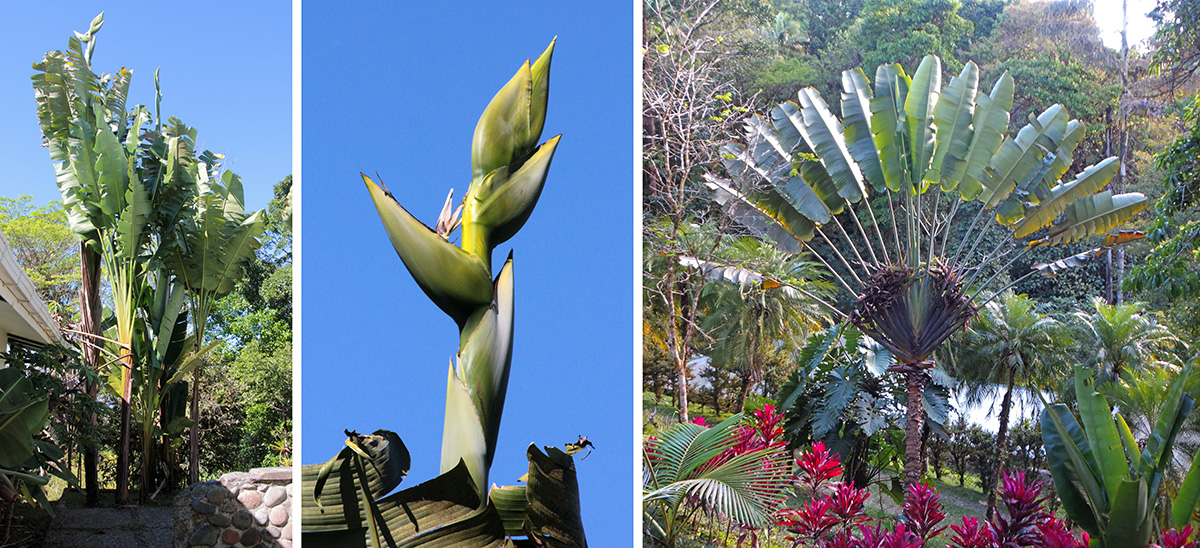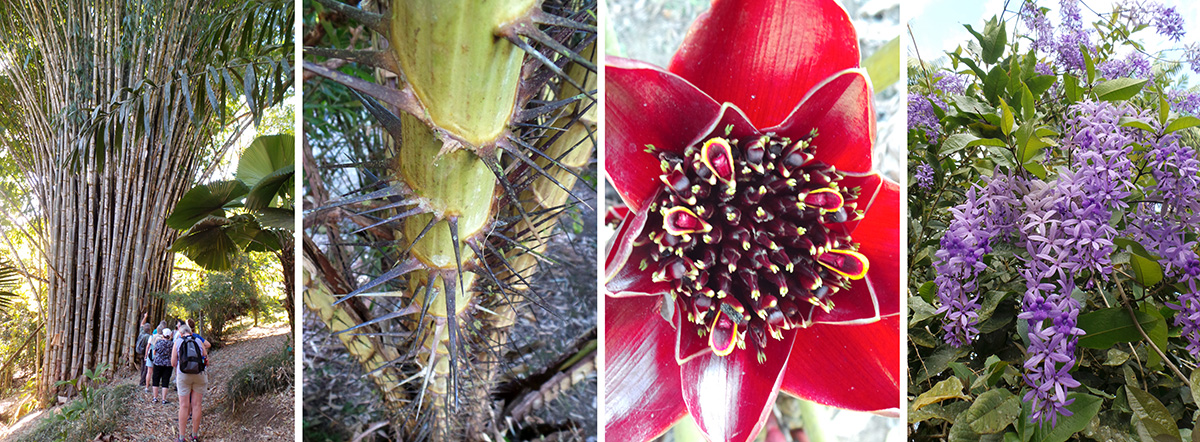We got up early to make the two hour drive south to spend the whole day at Wilson Botanical Garden, the most famous botanical garden in Central America. But before we ever arrived we had an excellent ornithological experience. Just as we were getting ready to move on from a quick bathroom stop where there were two impressive kapok trees (Ceiba pentandra), three scarlet macaws flew by, and then landed in a wild cashew tree across the road. We hopped back out of the bus to watch the large red, blue and yellow birds hanging in the treetop, one circling around to land in a different part or harass one of the other birds. The farm owner invited us to walk down his driveway for a better view of the colorful birds squawking at each other in the medium-sized tree. As we watched, a king vulture soared in the air behind us, obscured from view by one of the very nearby kapok trees, and an immature king vulture gave us a better view, while a large flock of orange-chinned parakeets flew over, chattering noisily.

Kapok tree, Ceiba pentandra (L), scarlet macaws (LC, C, RC) and king vulture (R).
We arrived at Las Cruces Biological Station, part of the Organization for Tropical Studies (OTS, a consortium of 60+ universities from around the world) where Wilson Botanical Gardens is located, about 9:35. The Station is located about 3,000 feet above sea level on a spur of the pacific coastal mountain range on about 800 acres of premontane wet forest. About 2/3 of the property is primary forest, with a range of elevations that allows for a high diversity of flora and fauna. Las Cruces started as the private nursery and experimental farm of Robert and Catherine Wilson in 1962. It was acquired by OTS in 1973, and continued their plantings and expanded the mission to include tropical research, especially in conservation biology and restoration. The 25 acres of landscaped gardens features a diversity of tropical and subtropical ornamentals from around the world, representatives of unusual plant families, and rare and endangered plants from Costa Rica and elsewhere. The garden has the second largest collection of palms in the world as well as large collections of ferns, aroids, bromeliads, gingers, heliconias, and marantas.

Entrance to Las Cruces Biological Station (L) and scenes from Wilson Botanic Garden.
We were fortunate to have the Station manager Rodolfo (Rodo) take us into the garden to learn about just a few of the many plants in the vast collections. He told us about the ornamental palm Pinanga kuhlii from Southeast Asia, pointing out its young inflorescences at the bottom, older ones up further, then green fruits and finally yellowing fruits at the top. Because these have the potential to be invasive, they try to remove the fruits before they turn purple or blue-black at maturity when they become attractive to birds that would inadvertently distribute the seeds. Next Rodo pointed out a tree fern from Polynesia that has the longest fronds of all ferns and a tall Caryota palm that is unusual because it blooms from the top down, only after 30-50 years, in comparison to most palms that bloom when they are much younger and start blooming from the bottom up.

The palm Pinanga kuhlii (L), a young inflorescence (LC), older inflorescence with fruits (C), new frond of tree fern (RC) and a Caryota palm (R).
Some other interesting plants included the wait-a-while palm (Calamus sp.) with its hooked spines all along the lax stems that aid in the plant ascending into the canopy as it grows; the primitive selaginellas, with their small, overlapping fern-like leaves, and the Calathea colony that stretched all along the walkway for about 50 feet. This mass of foliage was actually just three plants that had spread to fill the space, and those in the shade had their green-patterned leaves flat open, while adjacent sections in the sun had rolled up the edges.

Wait-a-while palm (L) with spiny stem (LC), a selaginella (C), and the Calathea colony in sun (RC) and shade (R).
Margherita set up her spotting scope so we could get a good look at one of the biggest moths in the world, Thysania agrippina(with up to a 12 inch wingspan and a number of common names including white witch and distributed from Mexico to South America), with its elongate wings spread out on a white tree trunk. This white and black patterned moth blended in perfectly with the lichens and other mottling on the tree trunk, making it fairly hard to spot despite its large size. Stopping to look at a native begonia growing on a tree trunk, we learned about these interesting plants that produce male flowers first that have lots of nectar to make them attractive to bees and other pollinators. Only after those flowers have faded are any female flowers are produced. The female flowers look similar to the male flowers, but don’t produce any nectar, so pollinators that have been getting rewarded from visits to male flowers are tricked into visiting – expecting to get nectar – and pollinate the flowers without the plant having to provide anything.

Tall tree with white witch moth on trunk (L), closeup of moth (LC), begonia inflorescence on tree (RC) and unidentified gesneriad (R).
Rodo showed us the colorful inflorescence of Musa coccinea, then peeled back one of the bright red bracts to expose the pale yellow fruit. He noticed some fluff on the plant and picked off the bromeliad seeds to explain how many species are distributed on the wind, sticking to trees and other surfaces where they germinate and grow. We also looked at the inflorescences of hybrid cultivated bananas, M. rosea, and M. violacea to compare how the flowers and fruits are produced in the different species. We had made a loop around the area, and on the way back to the building stopped to look at a pair of tagua (Phytelephas aequatorialis), a monoecious palm native to Ecuador that produce very large, hard fruits. The taller male palm was in flower, with a long pendant inflorescence of a chain of large, fluffy-looking blobs swarming with tiny bees and wasps, while the female had large, old rounded inflorescences at the base of its fronds. These stay on the tree for several years to ripen the big “nuts”. Our last plant before lunch was a Ceiba pentandra planted in 2005, with a slightly bottle-shaped base and a number of stout thorns on the trunk (presumably to deter megafauna that are now extinct).

Rodolfo shows the group the fruit of Musa coccinea (L), the flowers of M. rosea (LC), the fruit and flowers of M. violacea (C), tagua nuts (RC) and thorns on Ceiba pentandra trunk (R).
After lunch we watched birds coming in to the bananas placed on a wooden platform. A single silver-throated tanager was the first visitor, but eventually a few more of that species, palm tanager, a clay-colored robin, a bright turquoise male green honeycreeper, and a couple of speckled tanagers came to stuff themselves full of banana. Most of us then went to see more plants, but the few who chose to stay behind also got to see golden-hooded tanager, buff-throated saltator, blue-grey tanager, and many more of the ones we’d seen once the area got quieter.

Birds at the platform feeder (L): silver-throated tanager (LC), speckled tanager (RC), and male green honeycreeper (R).
On the way down to see the greenhouse we stopped to look at a traveler palm from Guiana (Phenakospermum guyannense) that had its huge, bat-pollinated inflorescence sticking way up above the banana-like leaves. There is another plant from Madagascar with the same common name of traveler palm (Ravenala madagascarens) that superficially looks the same, but the flowers are borne near the base of the leaves, and the leaves spread out in a much wider fan.

Traveler palms: Phenakospermum guyannense (L) and inflorescence (C), and Ravenala madagascarens (R).
The greenhouse had a small collections of aquatic and insectivorous plants, including pitcher plants from the Americas (Sarracenia), sundews and other things, and hanging pots of pitcher plants (Nepenthes), some of which were in bloom with a long, skinny flower spike sticking up from the plants. Other interesting plants there included Ruscus hypoglossum with its little flowers coming out of what looked like a thorn in the middle of the leaf, a variety of succulent and pepperomias, some monstrous staghorn ferns, and Columnea arguta with waxy leaves on hanging stems and large, erect, bright orange hooded flowers.

Pitcher plants (L), sundews (LC), a flower of Ruscus hypoglossum (C), staghorn ferns (RC), and Columnea arguta flowers (R).
We also saw some impressive clumps of different species of giant bamboos from China and Japan, the 30 foot tall plants creaking in the wind as we walked underneath them; a bamboo from Columbia that has spines on the lower branches; and another species from Southeast Asia with stems covered with wide, ferocious spines. Rodo told us how he tried to use the roots of the red ginger plants, Etlingera hemisferica, like culinary ginger when he first came to the station, but it was a failed experiment as they are not edible. The inflorescences on short stalks are fairly attractive, with tiny yellow-tipped flowers in a cup of bright red bracts. The bromeliad garden has a number of epiphytic and terrestrial species, including Pitcairnia corralina from Columbia and Peru, whose red inflorescence grows down to the ground rather than upwards because it is pollinated by small hummingbirds who forage close to the ground. In another area there were a couple of large plants of purple-flowering Queen’s wreath (Petrea volubilis) and Rodo had us feel the leaves to explain the origin of its other common name of sandpaper plant.

The group walks under giant bamboo (L), spines on Southeast Asian palm Salacca edulis (LC), inflorescence of Etlingera hemisferica (RC) and purple flowers of Petrea volubilis (R).
Our final exciting experience was in the cycad collection, when Rodo told us about a butterfly that uses one of the species as a host plant. The gregarious white-striped red caterpillars of the Atala butterfly (Eumaeus atala) feed only on the tender young foliage, and then pupate in groups on the undersides of the leaves. We first found a few pupae, then discovered a group of small larvae, and a batch of eggs. As the group headed back down the hill Susan discovered an adult sitting on a cycad stem with its wings folded up. The underside of the wings are mostly black with three rows of white dots along the outer edge of the hindwing and a red patch at the bottom of the hindwing. Susan caught up with the group, then led a few others back to see the butterfly. After taking several pictures they discovered the butterfly had remained in place so long not because it was starting to get windy, but because it was laying eggs! We got to see all stages of this insect, not a very common occurrence.

Atala butterfly, Eumaeus atala, hatched eggs (L), group of young larvae (LC) and closeup (C), pupae on underside of cycad leaf (RC) and adult female laying eggs (R).
